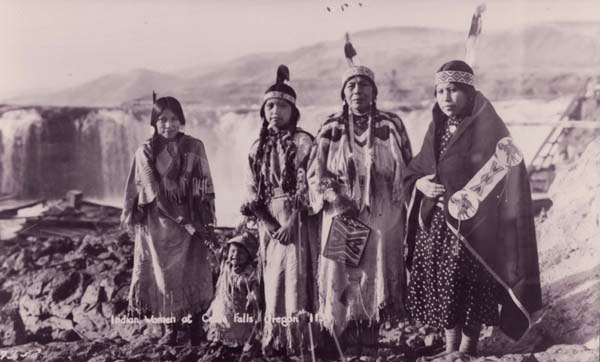Plateau Culture
The Plateau peoples lived in band societies that formed and dispersed with seasonal activities. Chiefs were appointed to these seasonal villages. Although the appointment may be inherited from a father, a new chief was required to prove his worthiness to the band. The chief's influence over the band was limited to suggestion or recommendation, although he could create alliances with outside groups. Intermarriage was practised to solidify these political and economic unions. Slaves, particularity women, were taken during warfare and often married to their captors. Despite their close trading ties with the coast, the Interior Salish groups did not adopt Northwest Coast class systems. Rather, each small group of several related families recognised the authority of a hereditary chief. An informal council of elders assisted the chief. The Kootenay followed a similar system, whereby each group had a hereditary leader supported by a council of elders. A special chief was elected both for the annual buffalo hunt across the foothills of the Rocky Mountains and for the times the Kootenay were at war, particularly with the Blackfoot. Hunting territory belonged to the group as a whole, although some families laid claim to specific fishing stations and berry-picking grounds. Individuals specialised in certain skills such as tanning or basket making.
 Trade and warfare were often interlinked activities, access to preferred fishing territories being the object of warfare and trade. A key fishing territory protected the salmon suppliers from attack because they were central to providing salmon for neighbouring bands. Trade systems were often networked around preferred fishing sites. The advantaged group could then act as middlemen and exchange captives between warring groups. A system of conflict and exchange was utilised to gain economic control over a territory. The valuable fishing platforms used during the harvesting of spring salmon were passed from father to eldest son through a daughter or other female family member.
Trade and warfare were often interlinked activities, access to preferred fishing territories being the object of warfare and trade. A key fishing territory protected the salmon suppliers from attack because they were central to providing salmon for neighbouring bands. Trade systems were often networked around preferred fishing sites. The advantaged group could then act as middlemen and exchange captives between warring groups. A system of conflict and exchange was utilised to gain economic control over a territory. The valuable fishing platforms used during the harvesting of spring salmon were passed from father to eldest son through a daughter or other female family member.
The Plateau peoples participated in trade with Pacific Coast groups. Amongst the Interior Salish, the Lillooet became the chief intermediary in coastal trade. They shipped dried berries, tanned skins, and mountain goat wool to the coast. In return, they received seashells and dugout canoes. Dried, preserved fish, rather than fresh fish, was the preferred commodity. The salmon taken from the Fraser River was prized because it was high in fat and air-dried. Lillooet peoples who had fishing territories along the Fraser River traded salmon for trout from the Thompson and Kuntani (Kootenay). Dried salmon and salmon oil were exchanged for goods such as dentalium shells, dried seafood, and coastal woods and berries from the Pacific Coast bands. The favourable trade position of certain Plateau groups, such as the Lillooet and Canyon Shuswap, enabled their members to accumulate wealth.
 Communities also exchanged ideas and values regarding social systems, technologies, and economies, in addition to goods. In exchange for skins and moccasins, for example, the Carrier tribe obtained cedar boxes and blankets woven by the Alaskan Chilkat people from the Bella Coola and Tsimshian of the Pacific Coast. As a result of these transactions, the Carrier assimilated the stratified social system of the Pacific Coast tribes and began restructuring their population into nobles, commoners, and slaves. Intermarriage with the Tsimshian helped strengthen this process. Both the Chilcotin and the Tahltan adopted similar social systems: the Chilcotin through their fur trade with the coastal Bella Coola, and the Tahltan by way of trade activities with the Alaskan Tlingit of the Pacific Coast.
Communities also exchanged ideas and values regarding social systems, technologies, and economies, in addition to goods. In exchange for skins and moccasins, for example, the Carrier tribe obtained cedar boxes and blankets woven by the Alaskan Chilkat people from the Bella Coola and Tsimshian of the Pacific Coast. As a result of these transactions, the Carrier assimilated the stratified social system of the Pacific Coast tribes and began restructuring their population into nobles, commoners, and slaves. Intermarriage with the Tsimshian helped strengthen this process. Both the Chilcotin and the Tahltan adopted similar social systems: the Chilcotin through their fur trade with the coastal Bella Coola, and the Tahltan by way of trade activities with the Alaskan Tlingit of the Pacific Coast.